
Spiders can be found in your home all year round, but you might notice them more in winter. While they eat insects, no one really wants spider as housemates, and certain types of spiders are scarier than others. Knowing which one is which is essential – especially since not everything with eight legs is a spider.
Spiders are part of a large animal group called Arthropods, which contains invertebrate creatures with jointed legs and usually a segmented body. Inside the Arthropod group are five major classes – arachnids, which includes spiders, scorpions and mites; insects; diplopoda, which includes millipedes; chilopoda, which includes centipedes; and crustaceans, including crabs, lobsters, crayfish, and prawns. Centipedes and millipedes are sometimes grouped together as myriapoda. After classes, animals are then divided into categories known as orders. True spiders belong to the Araneae order.
Daddy Long Legs are the most confusing. Creatures officially given that name are also called harvestmen and belong to the order Opiliones. They have long, jointed legs but don’t produce silk or webs and only have two eyes. They also live outside under rocks and logs, and almost never venture indoors. What most people refer to as “daddy long legs” are actually the cellar spider described below.
A Guide to Spiders on Long Island
All spiders produce venom, but none of the spiders commonly found on Long Island have a venom strong enough to pose a health risk for humans. In fact, some forms of spiders, such as the yellow sac spider, only want to use their venom on edible prey, which humans are not.
American House Spiders
 Less than a quarter of an inch, this small spider is brown with dark rings on the legs. Males have orangish legs while the females have yellowish legs. Also called common house spiders because they’re so easy to find; this spider builds webs in the corners of rooms, attics, basements, barns, and sheds.
Less than a quarter of an inch, this small spider is brown with dark rings on the legs. Males have orangish legs while the females have yellowish legs. Also called common house spiders because they’re so easy to find; this spider builds webs in the corners of rooms, attics, basements, barns, and sheds.
American house spiders usually run away from humans because they’re not aggressive and have poor eyesight, biting only in self-defense. While their bite can be painful, it’s not lethal to humans. Because they eat pests like flies and mosquitoes and aren’t aggressive to humans, many people try to coexist with this form of spider.
Black and Yellow Garden Spiders
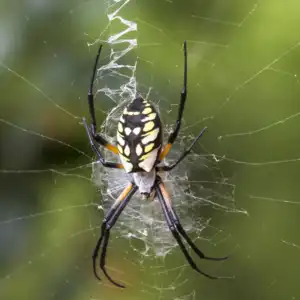 Its coloring makes this a fairly noticeable spider. Female black and yellow garden spiders bodies are a little longer than an inch while males are significantly smaller. Their third set of legs is about half the length of the other sets. Also known as corn spiders, golden garden spiders, golden orb-weavers, writing spiders, zipper spiders and yellow garden Argiope; they’re especially noticeable in late summer.
Its coloring makes this a fairly noticeable spider. Female black and yellow garden spiders bodies are a little longer than an inch while males are significantly smaller. Their third set of legs is about half the length of the other sets. Also known as corn spiders, golden garden spiders, golden orb-weavers, writing spiders, zipper spiders and yellow garden Argiope; they’re especially noticeable in late summer.
The females spin orb webs with a white zigzag structure in the middle called a stabilimentum. Black and yellow garden spiders eat anything trapped in their webs with the female eating the entire web at night and then spinning a replacement. This spider generally stays outdoors, as its name indicates, and is harmless to humans. They’re often viewed as gardeners’ helpers because they eat insects that would otherwise be a problem.
Cellar Spiders
 Because of their long legs, cellar spiders are often referred to as “daddy long legs” but this version is a true spider unlike the member of the order Opiliones (which is frequently called the same). Also called long-bodied cellar spiders; they have eight eyes, a sectioned body and are beige, light brownish-tan or gray.
Because of their long legs, cellar spiders are often referred to as “daddy long legs” but this version is a true spider unlike the member of the order Opiliones (which is frequently called the same). Also called long-bodied cellar spiders; they have eight eyes, a sectioned body and are beige, light brownish-tan or gray.
Cellar spiders build webs they use to trap and eat gnats, flies, other spiders, moths, mosquitoes and other common indoor pests. Cellar spiders will even eat black widow spiders. They are frequently found in homes, sheds or garages.
Crab Spiders
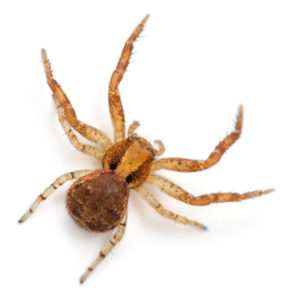 Easy to identify because their front four legs are significantly bigger than the back ones, crab spiders are named because their appearance and movement is reminiscent of the crustacean. Unlike other spiders that tend to be brown, black, etc., crab spiders’ coloring can be extremely varied, which makes it easier for them to hide among flowers, leaves, fruit, etc. Size can likewise vary with a body length of 4-10 cm.
Easy to identify because their front four legs are significantly bigger than the back ones, crab spiders are named because their appearance and movement is reminiscent of the crustacean. Unlike other spiders that tend to be brown, black, etc., crab spiders’ coloring can be extremely varied, which makes it easier for them to hide among flowers, leaves, fruit, etc. Size can likewise vary with a body length of 4-10 cm.
Crab spiders make their homes outdoors in grass, branches of fruit trees, plant leaves, etc. While classified as hunter spiders, they aren’t aggressive. Instead they lay in wait until prey comes too close using their long front legs to grab them and inject prey with venom to immobilize them. Regarding humans and other predators, crab spiders are downright timid and will flee rather than attack. Since their venom is weak to humans and their fangs rarely break skin, they’re considered harmless to humans.
Fishing or Nursery Web Spiders
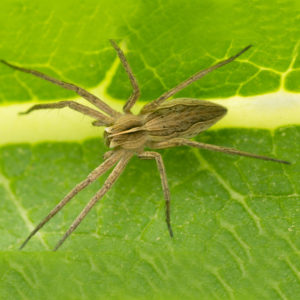 Nursery web spiders are among the largest of true spiders, often leading people to mistake them for tarantulas. Their bodies can range from a quarter of an inch to an inch in size and with legs extended they can be as long as three inches. They have dark brown stripes or markings over a tan, gray, beige or buff base colors. They have eight eyes aligned in two rows with the upper row slightly larger.
Nursery web spiders are among the largest of true spiders, often leading people to mistake them for tarantulas. Their bodies can range from a quarter of an inch to an inch in size and with legs extended they can be as long as three inches. They have dark brown stripes or markings over a tan, gray, beige or buff base colors. They have eight eyes aligned in two rows with the upper row slightly larger.
Nursery web spiders carry their egg sac in their fangs or under her body until ready to hatch. While they spin silk, they don’t use a web to capture prey. Instead they hide and spring out to catch prey. Rarely found indoors, they primarily live near water, in woods, gardens, farms, grasslands, rocky areas and fields.
Funnel or Grass Spiders
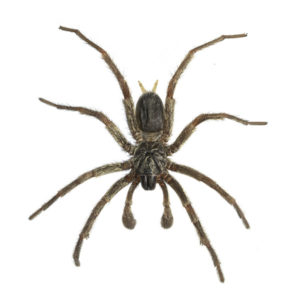 A very common form of spider, the females are about 10-20 millimeters and the males about 9-18 millimeters long. Funnel spiders or grass spiders have bristly legs and are brown with markings in gray, black and/or tan. Categorized as beneficial predators, they rarely leave their nests and so they’re generally not found in homes.
A very common form of spider, the females are about 10-20 millimeters and the males about 9-18 millimeters long. Funnel spiders or grass spiders have bristly legs and are brown with markings in gray, black and/or tan. Categorized as beneficial predators, they rarely leave their nests and so they’re generally not found in homes.
If a human does encounter them, grass spiders tend to run away fast and only bite in self-defense. However, their bite is painful – causing redness, itching and swelling for one to ten days but generally no serious consequences. They’re referred to as “grass spiders” due to their most common habitat and “funnel spiders” because of their webs which are big, generally horizontal and sheet-like, somewhat concave, and have a tunnel or funnel on one side.
Nocturnal Orb-Weaving Spiders
 Orb-weaving spiders are a very large group with a great deal of variety in their appearance, making them difficult to identify by appearance. Fortunately, their namesake webs are identifiable as circular grids much like those shown in Halloween decorations – radial silk strands like wheel spokes connected with concentric circular stands. The webs can be up to three feet in diameter and the orb-weaving spiders are often found hanging in their webs in a head down position.
Orb-weaving spiders are a very large group with a great deal of variety in their appearance, making them difficult to identify by appearance. Fortunately, their namesake webs are identifiable as circular grids much like those shown in Halloween decorations – radial silk strands like wheel spokes connected with concentric circular stands. The webs can be up to three feet in diameter and the orb-weaving spiders are often found hanging in their webs in a head down position.
Some varieties of nocturnal orb-weaving spiders take down their webs in the morning at dawn to consume any dew on it along with the moths, beetles, wasps, mosquitoes, flies, etc. trapped on it. This also prevents birds from getting caught in the web. Then at dusk they spin a new web. Orb-weaving spiders tend to be shy and reluctant to bite humans. If they do it can cause numbness, dizziness, nausea and swelling but isn’t a serious danger.
Sac Spiders
 Sac spiders have several subvarieties with the yellow sac spider being the best known. Sac spiders get their name because they often appear to be carrying a “sac”. Their bodies can appear brown, tan, yellow or greenish with a short, dark line in the center of their abdomen. Their pale legs have dark feet.
Sac spiders have several subvarieties with the yellow sac spider being the best known. Sac spiders get their name because they often appear to be carrying a “sac”. Their bodies can appear brown, tan, yellow or greenish with a short, dark line in the center of their abdomen. Their pale legs have dark feet.
Sac spiders are fast runners. They’re predatory hunter spiders rather than using webs to trap prey. Instead, they use their spider silk to create tent-like sacs for retreats. Outdoors, they tend to make their sleep sacs under or between leaves, under logs, etc. In a home, they tend to make their sacs high up in corners, behind pictures or around windows.
While not naturally aggressive to humans, they will bite defensively. Inside a home, while wandering to find food, sac spiders will sometimes rest in piles of clothing or other laundry left on the floor. If that laundry is then moved, they may fear being crushed causing them to rush out and bite the threat – your hands – or try to bite their way through the clothing and get you in the process. While sac spiders don’t have a venom lethal to humans, those sensitive to spider venom could have a serious reaction. The area bitten can stay tender and sore for days.
Yellow sac spiders are just one variant of sac spiders but a common one on Long Island. They’re nocturnal and follow the description above, but their appearance is a little different. Obviously, they’re yellow. Their legs are longer than their body and their front two legs are longer than the other six. Their legs are yellow and tipped with black feet.
Sheet Web Weavers
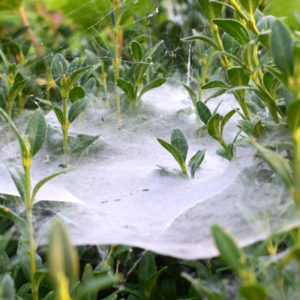 The Sheet Web Weaver spider takes its name from the web it produces – flat and sheet-like as well as domed or cuplike. The spider itself is small – 6 millimeters or less – and is usually found in a lower part of the web or between two layers of the web. Forest-dwelling spiders make their webs in trees, anchoring them on leaves or needles. Since their webs take several days to create, they’re more “expensive” in terms of silk so they don’t change or replace them as frequently.
The Sheet Web Weaver spider takes its name from the web it produces – flat and sheet-like as well as domed or cuplike. The spider itself is small – 6 millimeters or less – and is usually found in a lower part of the web or between two layers of the web. Forest-dwelling spiders make their webs in trees, anchoring them on leaves or needles. Since their webs take several days to create, they’re more “expensive” in terms of silk so they don’t change or replace them as frequently.
Sheet web weavers also use their spider silk to create a balloon that allows them to travel long distances. Because they eat flies, aphids, tiny wasps, leafhoppers, and other garden pests, sheet web weavers are often considered beneficial. They’re also not known for biting people, except in self-defense.
Wolf Spiders
 Because they are hairy, sometimes large and either gray, black or brown, wolf spiders are often mistaken for tarantulas or brown recluse spiders. While they live on the ground and under rocks in fields, woods, gardens, riverbanks, and beaches, wolf spiders head indoors in the fall seeking warmth so they’ll hide in windows, doors, garages, basements and on houseplants.
Because they are hairy, sometimes large and either gray, black or brown, wolf spiders are often mistaken for tarantulas or brown recluse spiders. While they live on the ground and under rocks in fields, woods, gardens, riverbanks, and beaches, wolf spiders head indoors in the fall seeking warmth so they’ll hide in windows, doors, garages, basements and on houseplants.
Some people keep wolf spiders as pets because they don’t attack humans unless threatened. Even if they do bite, their venom isn’t very dangerous to humans. When pursuing prey, however, they are aggressive. They hunt food instead of trapping it in webs, eating ground insects and other spiders.
Spider Problem? Call Arrow!
If you’re still not sure what kind of spider is in your house or you have other concerns, call the experts at Arrow Exterminating to provide the right solution. We can offer thorough inspections of your home, assess possible infestations, and provide extermination services. To get started, contact us today.




